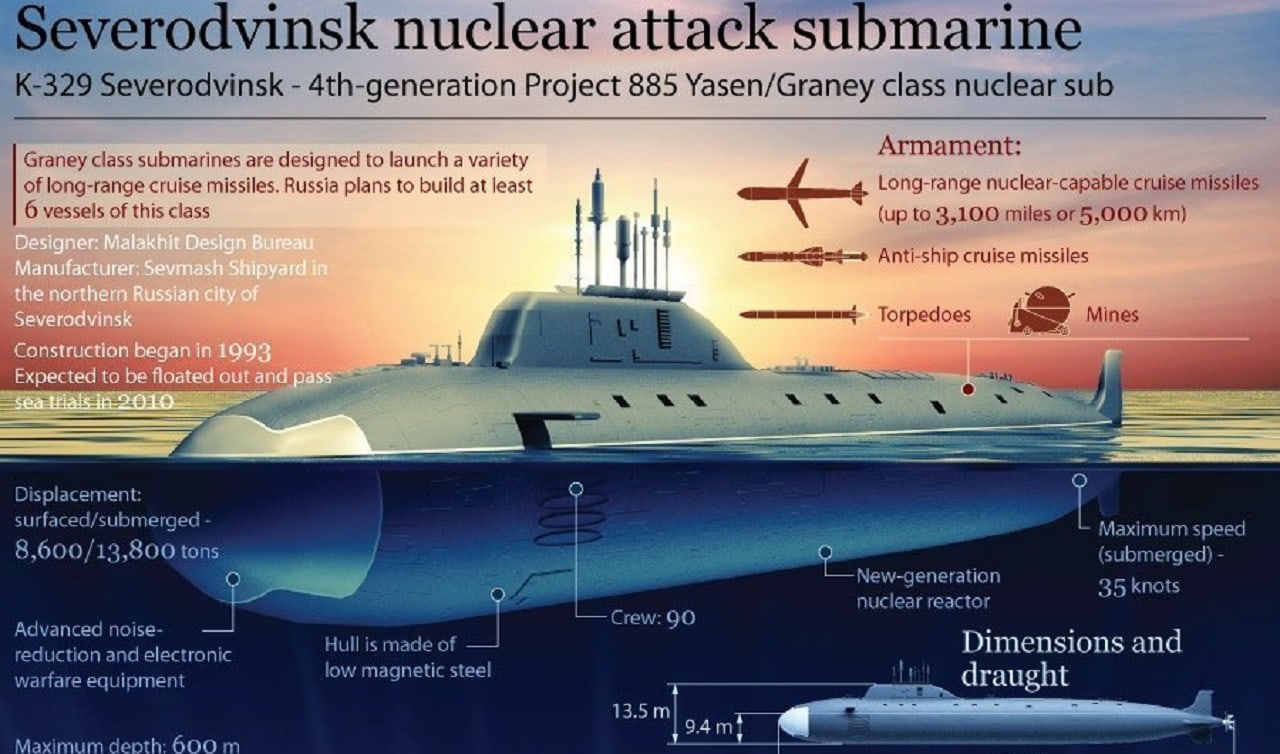The Yasen-M Class Submarine: Mainstay of Russia’s Future Submarine Force – Russia’s Yasen-M class is one of the most modern submarine classes in Russian service today. Known as a very quiet and hard-to-detect submarine, the Yasen is intended to attack land and sea targets in a conflict with the United States or other Western powers. With many examples of the class currently under construction, it is clear that Russia continues to make the submarine a central element of its submarine force in the future.
Yasen-M, Explained
With a Russian name that translates to “ash tree” in English, the Yasen-M is the most current iteration of the Yasen class of submarines.
Displacing 13,800 tons and measuring 393 feet from bow to stern, the Yasen-M is a particularly large cruise missile submarine.
In terms of armament, the Yasen-M is equipped to carry a 72-unit combination of Kalibr ground attack missiles as well as Oniks or Zircon anti-ship missiles, as well as 30 torpedoes across ten torpedo tubes.
As a result of being powered by a single modern KTP-6 monoblock reactor (as opposed to the older OK-650 reactor in the Severodvinsk, the first submarine of the Yasen class), the Yasen-M can operate autonomously for 100 days and travel silently at a speed of almost 28 knots.
Several Yasen and Yasen-M class submarines have been built to date. While the original Yasen, the Severodvinsk, was launched in 2010, the first Yasen-M was launched in 2017 after roughly eight years of construction on the submarine.
Named the Kazan, the first iteration of the Yasen-M was shorter in length than the original Yasen, and featured a switch to single-hull construction and upgrades to the submarine’s cooling system to make the submarine travel more quietly.
An additional Yasen-M known as the Novosibirsk was commissioned into the Russian navy in December 2021, making it the third Yasen series and second Yasen-M to enter service to date.
Following the delivery of the Novosibirsk, three additional Yasen-Ms remain in active production.
While the Severodvinsk and Kazan have been assigned to the Russian Northern Fleet, the Russian Navy’s main oceangoing fleet, the Novosibirsk was assigned to the Russian Pacific Fleet, drawing attention to the ships’ potentially intended global role.
Why the US Navy Hates the Yasen-M
American naval leaders have vocally raised concerns that Yasen and Yasen-Ms such as the Kazan are capable of slinking around the Atlantic with impunity and could conceivably do major damage to selected targets in the American homeland in the event of a large-scale war.
In a 2019 interview with 60 Minutes, the then-head of United States Naval Forces Europe-Africa Admiral James Foggo expressed concern about the Severodvinsk’s quiet functioning, which the Pentagon said allowed the submarine to evade U.S. detection for weeks.
Yasen-M Is Evolution for the Russian Navy
In keeping with its emphasis on being one of the quietest submarine classes in the Russian Navy, the Yasen-M could represent an evolution in how the Russian Navy thinks about its submarine fleet.
According to a 2021 report from the British think tank RUSI, Yasen-Ms could be intended to be the nimble and quiet guided-missile submarines that carry out limited, targeted strikes on enemy targets around the Atlantic in a sort of relatively limited interstate conflict which Russian strategic thinking has begun to plan for.
In addition, if allowed to operate in the wider Atlantic in the event of such a war, Yasen and Yasen-Ms could inflict significant damage on Western naval forces operating in the Atlantic, even if Russian ELINT networks may not be up to their hoped-for effectiveness.
The Yasen-M is a technologically capable submarine that, assuming the current procurement of additional Yasen-Ms continues, will be a workhorse of the Russian Navy for years to come. Its usefulness in confrontation with Western countries will be dependent on its ability to avoid detection through its relatively quiet nature.
Wesley Culp is a Research Fellow at the Center for the Study of the Presidency and Congress. He regularly writes on Russian and Eurasian leadership and national security topics and has been published in The Hill and the Diplomatic Courier. He can be found on Twitter @WesleyJCulp.

